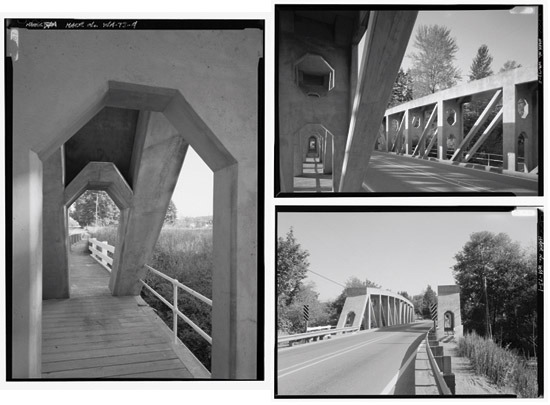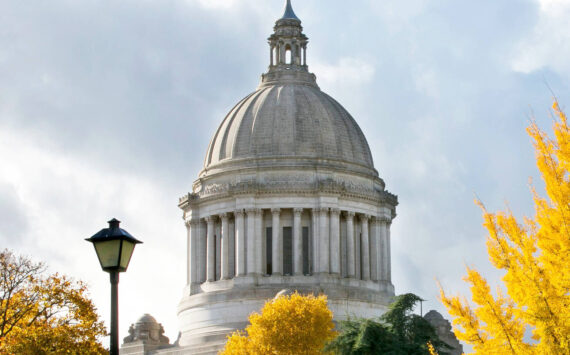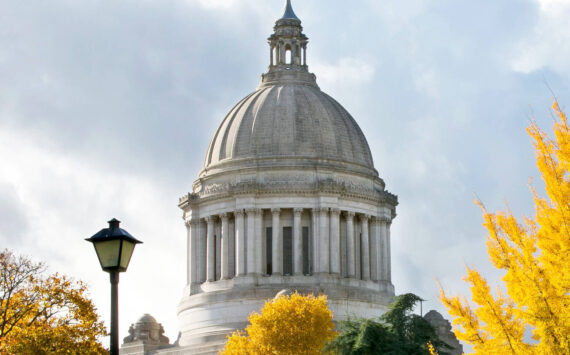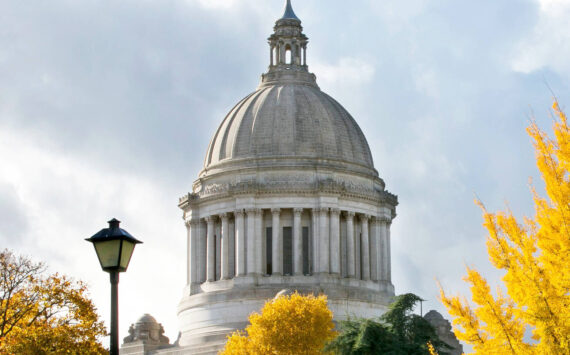The Pierce County Landmarks and Historic Preservation Commission is scheduled Tues., May 10 at 5:30 p.m. to conduct a site visit of the State Route 162 McMillin / Puyallup River Bridge, a 77-year-old structure that is listed on the National Register of Historic Places and now faces an uncertain future.
According to the Washington State Department of Transportation (WSDOT), the aging bridge with historical significance is not only too narrow to safely accommodate today’s traffic, but is showing signs of deterioration. WSDOT engineers are designing a new bridge immediately downstream of the McMillin Bridge with a wider roadway that meets current engineering and safety standards. Construction is scheduled to begin in summer 2011.
The McMillin Bridge was built in 1934, replacing a steel span that had been washed out by the flooding river the year before. Due to the economic conditions of the time, a concrete design was chosen over steel. This design, which is unusual because it combines concrete with the half-through truss, also reduced overall maintenance costs. It also put the McMillin Bridge on the map in more ways than one. In addition to being on the National Register of Historic Places, the bridge is in the Library of Congress’ Historic American Engineering Record. The main span of the half-through truss bridge is 170 feet long, making it the longest beam span or concrete truss in the United States when it was constructed.
Adding to the uniqueness of the SR 162 McMillin / Puyallup River Bridge is the man who came up with the idea for its construction — Homer M. Hadley. Hadley, a structural engineer for the Portland Cement Association, is credited with the idea of building a floating concrete bridge across Lake Washington, according to WSDOT (the newest floating bridge there bears his name). He conceived the McMillin Bridge design in part to demonstrate the versatility of concrete. The W.H. Witt Company of Seattle prepared the construction documents that were executed by the general contractor Dolph Jones of Tacoma. The project was supervised by Pierce County engineer W.E. Berry and his successor Forest R. Easterday.
Because the bridge was placed on the National Register of Historic Places in 1982, WSDOT says it is complying with federal laws to develop and evaluate alternatives that avoid, minimize or mitigate effects that may be adverse to the structure. In November, the agency announced it was asking residents interested in the bridge to weigh in during an evaluation process and provide input on the future of the bridge. The public can contact the project office directly via e-mail or by calling (888) 323-7732, and can also request community briefings, and sign up to receive e-mail updates to get additional information about the project.
“This is a one-of-a-kind structure that’s on the National Historic Register, but it is aging and simply no longer meets motorists needs,” said Steve Fuchs, WSDOT project engineer. “Because of its historic status, we are required to alert the public about its significance and solicit input on what to do with it.”
Options being considered include rerouting the nearby Foothills Trail onto the McMillin Bridge, adding another segment to the Foothills Trail that utilizes the McMillin Bridge, leaving the bridge in place as a historical monument for interpretive purposes, or removing it in its entirety.
Following the Pierce County Landmarks and Historic Preservation Commission site visit, the commission will hold its regular meeting at 6 p.m. at the “Orting Bakery” conference room located at 212 Washington South, Orting. A photo presentation by Steven Meitzler, Chair of the Orting Historical Society, will lead off the meeting. Both events are open to the public.
To reach the bridge, head east on SR-410 towards Bonney Lake, take the SR-162 (Valley Ave) exit and go south towards Orting. Proceed approximately 4.4 miles towards Orting and you will approach the bridge. To the right (west) of the bridge is a parking/trail head for the Rails to Trail bike path.


- WSDOT’s State Route 162 McMillin / Puyallup River Bridge Web site
- Library of Congress’ Historic American Engineering Record
- Historical American Engineering Report on the SR 162 Puyallup River Bridge
- To contact WSDOT’s project office directly, request a community briefing, or sign up to receive WSDOT’s e-mail updates, fill out the form here.





